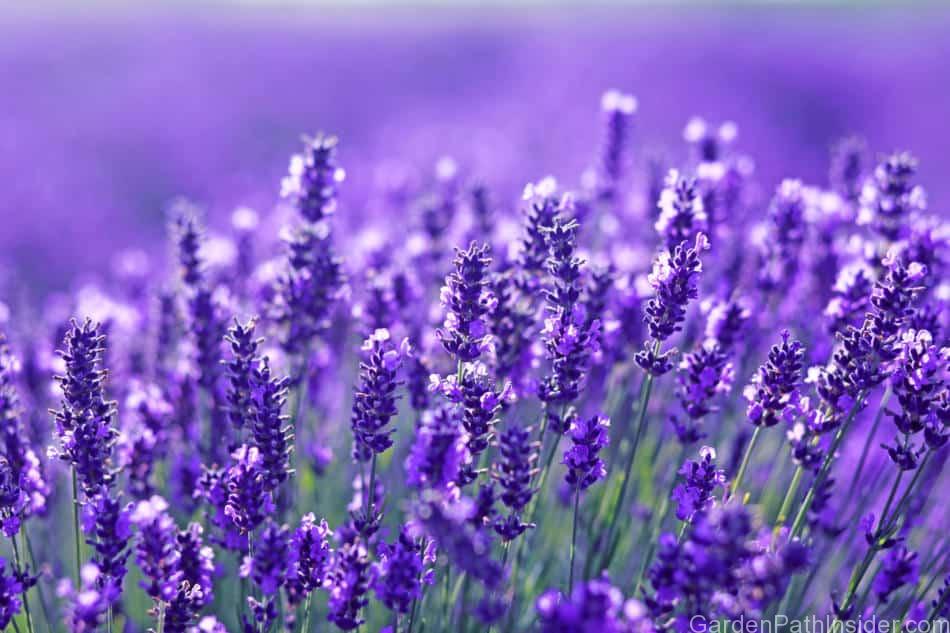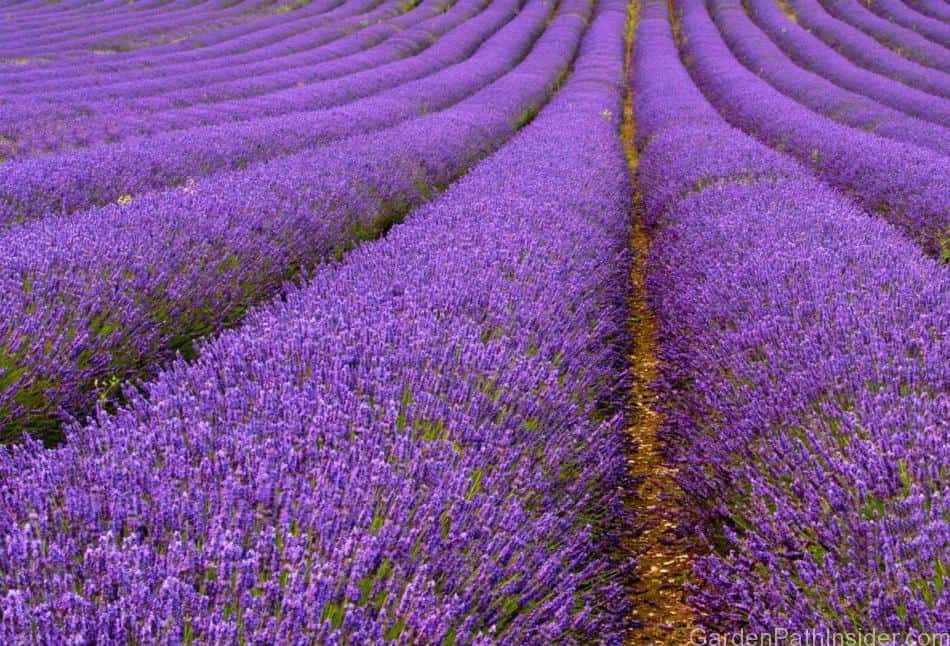
Growing lavender in hanging pots is a great way to introduce lavender to new locations in your garden or inside your home. Hanging lavender can be a creative display piece in your living room or help to extend the growing area of your outdoor garden.
Lavender can be grown in a hanging basket. Hanging lavender requires well-draining soil that is neutral to slightly alkaline. Place hanging lavender in a location with direct sun 4 to 8 hours per day. Lavender grows best in temperatures above 60°F to 70°F (15.5°C) during the day, and above 40°F (4.4°C) at night. Water as needed to maintain slightly damp soil.
Lavender is a wonderfully fragrant and colorful plant to decorate with. Lavender can be grown indoors or outside. There are a few considerations to keep in mind when growing lavender in hanging baskets vs growing in a garden bed or floor-based flowerpot. Below are listed the special attentions I take when growing lavender in a hanging basket.
Selecting the Right Hanging Basket for Your Lavender Plant
Lavender requires well-draining soil and plenty of sunlight to thrive. The variety of lavender grown will determine the size of the basket needed.
There are several styles of hanging baskets and the location of the basket will determine the style to use.
Growing Lavender in Hanging Baskets OUTDOORS
Hanging baskets of lavender that are grown outside will need to be able to adequately drain excess water from the soil in the basket. The best hanging baskets for outdoor use are made of metal wire with a liner made of natural fiber material. The fiber matting material will keep the soil in place in the basket while providing excellent drainage for any excess water in the soil. This drainage is key for draining excess rainwater out of the soil.
Growing Lavender in Hanging Baskets INDOORS
Hanging lavender baskets indoors can be a creative addition to any room. Most indoor hanging baskets are closed systems and do not have draining holes in the bottom of the baskets to drain excess water. This is great if you want to hang the lavender basket over a table or chair. However, you must be careful not to overwater the lavender as any excess water will drown the root system and the plant will die.
Look for a hanging basket that has a built-in water reservoir to allow excess water to drain from the soil, and then be reabsorbed by the soil as needed.
Selecting a Lavender Variety
Lavender varieties range from dwarf varieties to larger varieties grown in abundance on large scale lavender farms. Below are a few lavender varieties that range from small varieties to varieties that grow over 36 inches tall (91cm). With the wide variety of sizes lavender offers, you can pick the variety that will fit your available growing space.
Small Lavender Varieties
Thumbelina Leigh Dwarf English Lavender: This variety of lavender blooms summer to fall, and is a small variety that grows around 12 inches tall (30cm). Thumbelina lavender has traditional purple flowers and is recommended to plant in a pot at least 4 inches (10cm) in diameter and 4 to 6 inches deep (10 to 15cm). This small lavender is great for hanging baskets indoors where space is limited.
Blue river Lavender: Blue River Lavender blooms summer to fall, with a maximum growing height of about 14 inches (35cm). The flowers are traditional purple color and the lavender is able to tolerate hot and dry conditions very well. It is recommended to plant in a pot at least 4 inches (10cm) in diameter and 4 to 6 inches deep (10 to 15cm).
Mini blue lavender: produces beautiful blooms of purple flowers against grayish-green leaves. This small drought-resistant variety of lavender grows to a height of about 12 inches (30cm). Mini Blue is great for container gardens.
Larger Lavender Varieties
French lavender (Lavandula Dentata): French lavender blooms outlast most other varieties of lavender, with blooms beginning in summer and lasting into fall. This lavender grows as tall as 36 inches and spreads 36 inches (91cm tall, 91cm wide). French lavender is not as tolerant of the cold as other varieties and tends to have a less pronounced fragrance than other lavenders.

English lavender (Lavandula angustifolia): English lavender is a hearty variety of lavender that grows up to 36 inches tall and 36 inches wide (91cm tall, 91cm wide). The colors of English lavender flowers are rich purple, and the fragrances are prominent and aromatic. The relaxing fragrances of this lavender are used in household items like soap, candles, and essential oils.
Spanish lavender (Lavandula stoechas): Spanish lavender blooms with dark purple flowers and a sweet lavender fragrance and tends to tolerate heat better than other varieties. This lavender grows to a mature height up to 16 inches (40cm) tall with a spread of up to 18 inches wide (45cm).
Canary island lavender (Lavandula canariensis): Canary Island Lavender is a woody shrub-like variety of lavender with bright green leaves, bright blue flowers, and a very soft faint lavender scent. This lavender blooms for a long period of time during the season starting in Spring, and year-round in some climates. Canary Island Lavender grows up to 30 inches (76cm) tall and up to 30 inches (76cm) wide.
Soil Needs for Hanging Lavender
Lavender Soil Mix Recipe for Your Hanging Lavender Plant
Lavender needs a well-draining, neutral to mildly alkaline soil to thrive. Lavender can be grown in hanging pots using moderately fertile to sandy topsoil, or a well-draining potting soil from the local home store or purchased online, both types of soil work well. For more information read our article on growing lavender in pots.
How to Water Hanging Lavender Plants
Water hanging lavender plants thoroughly as needed to maintain a slightly damp soil. Lavender hanging outdoors in a well-draining basket can be watered thoroughly as needed.
Lavender grown in an indoor hanging basket should be watered very slowly to avoid overwatering the plant, as indoor hanging baskets tend to have no drainage hole in the pot for excess water.
Always check the soil moisture level before watering to avoid waterlogging the roots. To test the soil moister levels, gently press your finger into the soil, make sure to not poke the soil too deep or the roots may get damaged. If you feel any moister when you touch the soil, then your hanging lavender plant does not need water.
Sunlight Needs for Hanging Lavender Plants
Hanging lavender needs full sun for a minimum of 4 hours per day. For healthier lavender plants try to get a full 6 to 8 hours of direct sun each day. For outdoor growing, hang the potted lavender away from tall trees and shrubs to maximize the full day’s sun.
Indoor hanging lavender should be placed by a window that gets 4 to 6 hours of direct sun each day. Take care to rotate the plant every few days by simply turning the plant clockwise in place to get equal sun exposer to all sides of the plant.
Indoors lavender should be kept away from direct heating implements like space heaters, fireplaces, and heating vents as the direct heat can damage and dry out the lavender plant.
For more information read our article on growing lavender indoors.
Cover image: Lavender flowers at the field_© Olena Zaskochenko /123rf.com
